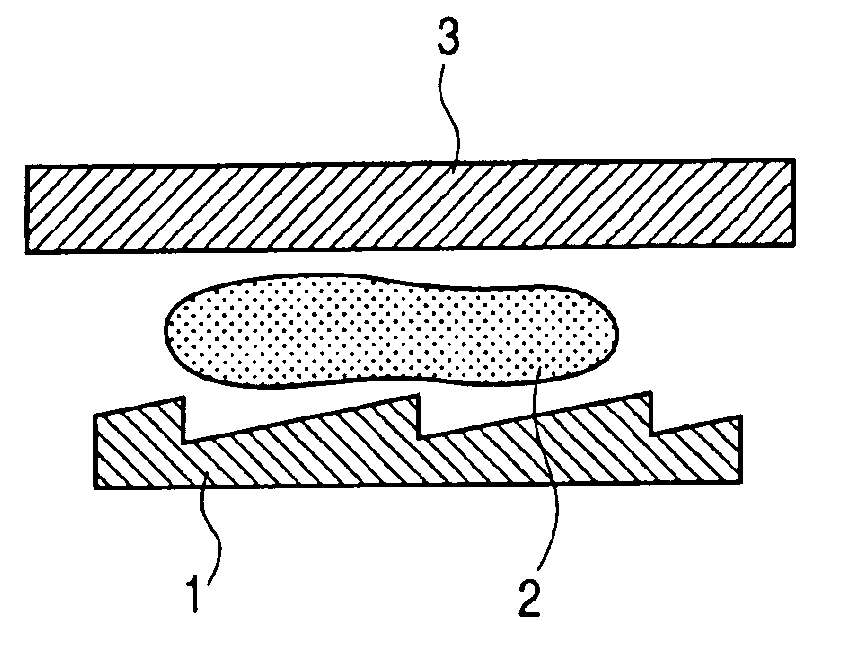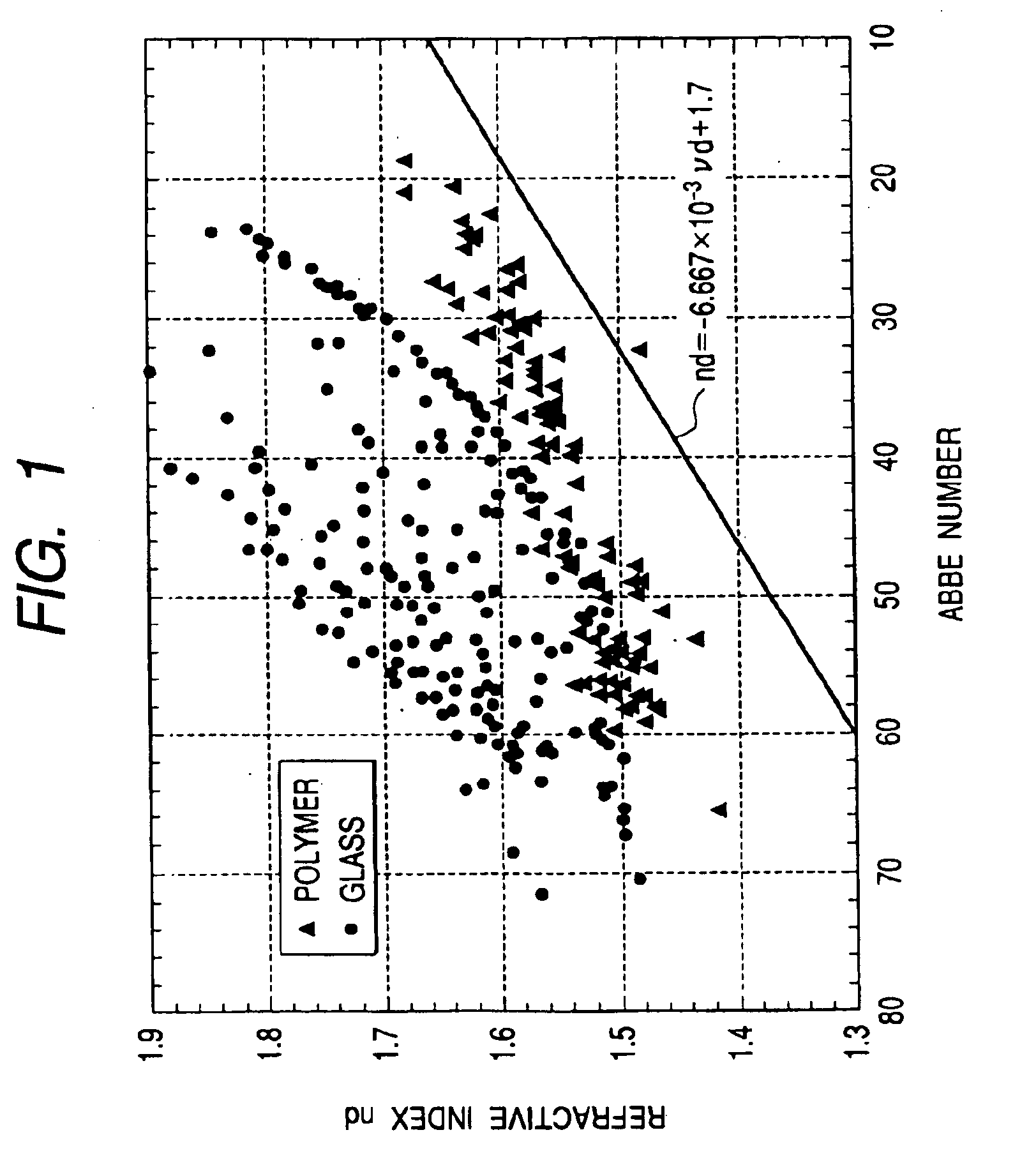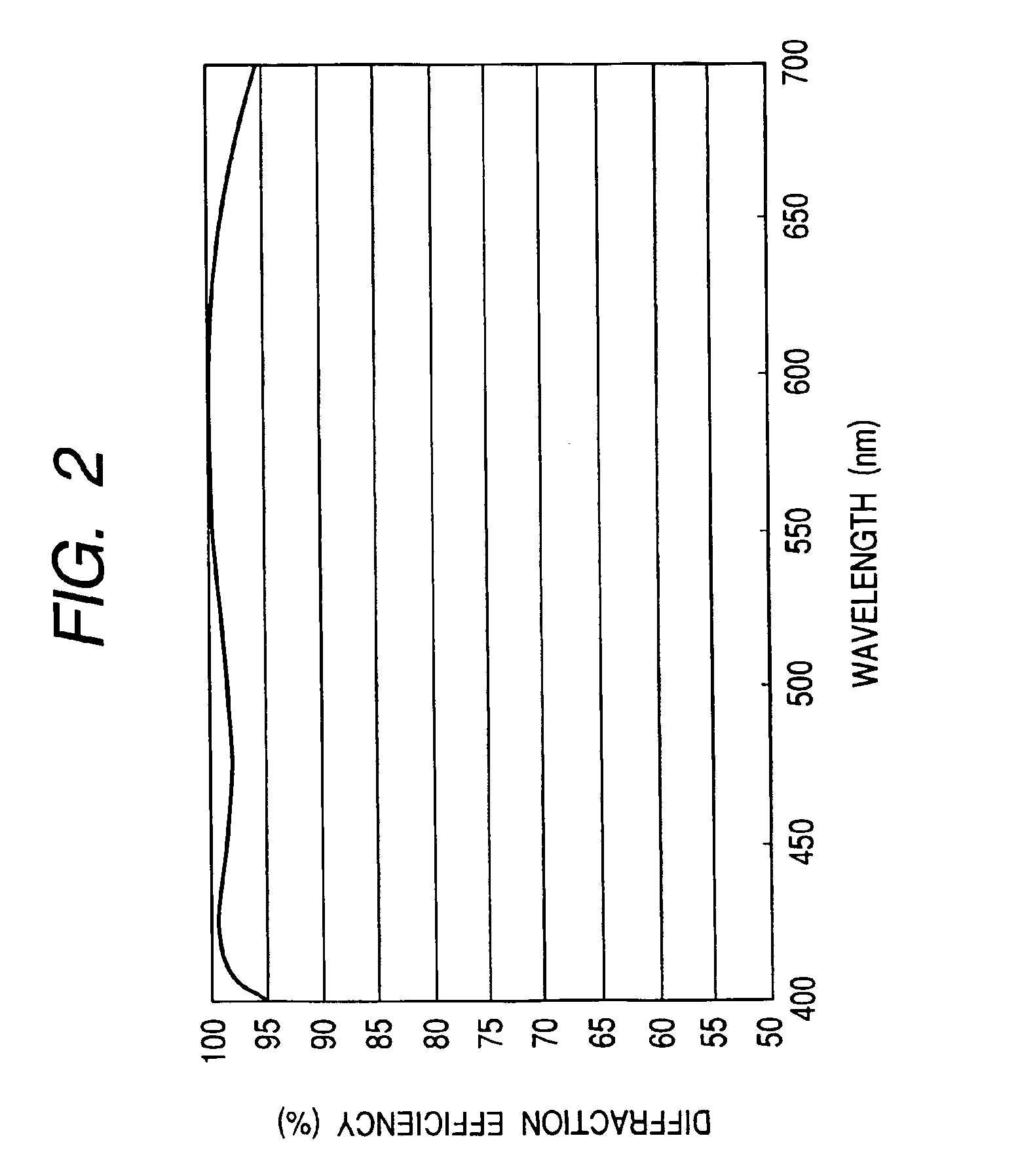Optical material, and, optical element, optical system and laminated diffractive optical element using it
a technology of optical elements and optical materials, applied in the field of optical materials for optical elements, can solve the problems of reducing diffraction efficiency and difficulty in obtaining sufficient correction of chromatic aberration, and achieve the effects of improving diffraction efficiency, reducing diffraction efficiency, and high dispersion
- Summary
- Abstract
- Description
- Claims
- Application Information
AI Technical Summary
Benefits of technology
Problems solved by technology
Method used
Image
Examples
example 1
[0064]The structure of a laminated diffractive optical element and a manufacture method thereof are described in this Example 1 with reference to FIGS. 5A, 5B and 5C to 8.
[0065]First, to 100 g of a 4.4 wt % dispersion in chloroform of ITO nanoparticles of 10 nm average particle size, 12 g of styrene monomer and 0.15 g of 1-hydroxycyclohexylphenyl ketone as photoinitiator were added, and then chloroform was removed under reduced pressure to obtain an optical raw material 2.
[0066]Then, as shown in FIG. 5A, the optical raw material 2 was put in a mold 1 machined for a diffraction grating. Subsequently, as shown in FIG. 5B, a flat glass plate 3 (BK7) was laid on the optical material 2, and irradiation was made with a dose of 20,000 mJ / cm2 (100 mW / cm2, 200 seconds) using a UV irradiation system (EX250: manufactured by HOYA-SCHOTT Co.). Then, as FIG. 5C shows, the cured optical material 2′ was released from the mold 1 as a diffractive optical element 4. During UV cure of the optical raw m...
example 2
[0070]The structure of a laminated diffractive optical element and a manufacture method thereof are described in this Example 2 with reference to FIGS. 9A to 9C, 6A to 6C, 10 and 11.
[0071]First, to 100 g of a 8.8 wt % dispersion in chloroform of ITO nanoparticles of 10 nm average particle size, 12 g of styrene monomer and 0.15 g of 1-hydroxycyclohexylphenyl ketone as a photoinitiator were added, and then chloroform was removed under reduced pressure to obtain an optical raw material 12.
[0072]Then, as shown in FIG. 9A, the optical raw material 12 was put in a mold 11 machined for a diffraction grating. Subsequently, as shown in FIG. 9B, a flat glass plate 13 (BK7) was laid on the optical material 12, and irradiation was made with a dose of 20,000 mJ / cm2 (100 mW / cm2, 200 seconds) using a UV irradiation system (EX250: manufactured by HOYA-SCHOTT Co.). Then, as FIG. 9C shows, the cured optical material 12′ was released from the mold 11 as a diffractive optical element 14. During UV cure...
example 3
[0076]The structure of a laminated diffractive optical element and a manufacture method thereof are described in this Example 3 with reference to FIGS. 12A to 12C, 6A to 6C, 13 and 14.
[0077]First, to 200 g of a 10 wt % dispersion in chloroform of ITO nanoparticles of 10 nm average particle size, 12 g of styrene monomer and 0.15 g of 1-hydroxycyclohexylphenyl ketone as a photoinitiator were added, and then chloroform was removed under reduced pressure to obtain an optical raw material 22.
[0078]Then, as shown in FIG. 12A, the optical raw material 22 was put in a mold 21 machined for a diffraction grating. Subsequently, as shown in FIG. 12, a flat glass plate 23 (BK7) was laid on the optical material 22, and irradiation was made with a dose of 20,000 mJ / cm2 (100 mW / cm2, 200 seconds) using a UV irradiation system (EX250: manufactured by HOYA-SCHOTT Co.). Then, as FIG. 12C shows, the cured optical material 22′ was released from the mold 21 as a diffractive optical element 24. During UV c...
PUM
| Property | Measurement | Unit |
|---|---|---|
| Abbe number | aaaaa | aaaaa |
| size | aaaaa | aaaaa |
| Abbe number | aaaaa | aaaaa |
Abstract
Description
Claims
Application Information
 Login to View More
Login to View More - R&D
- Intellectual Property
- Life Sciences
- Materials
- Tech Scout
- Unparalleled Data Quality
- Higher Quality Content
- 60% Fewer Hallucinations
Browse by: Latest US Patents, China's latest patents, Technical Efficacy Thesaurus, Application Domain, Technology Topic, Popular Technical Reports.
© 2025 PatSnap. All rights reserved.Legal|Privacy policy|Modern Slavery Act Transparency Statement|Sitemap|About US| Contact US: help@patsnap.com



